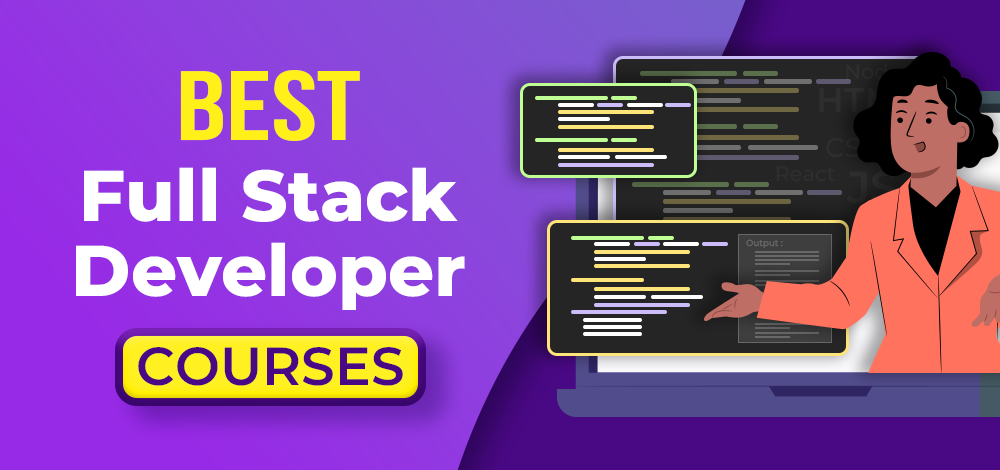Education
An Ultimate Guide To Choosing The Right Full Stack Developer Course

The tech world is rapidly evolving, and with it, the demand for skilled professionals who can juggle both front-end and back-end development—also known as full stack developers—is skyrocketing. However, with an ocean of courses out there, how do you pick the one that fits your schedule and budget and propels your career forward? In this article, we’ll guide you through the labyrinth of choices to help you find the perfect full stack developer course.
Understanding Full Stack Development
The Full Stack Phenomenon
What is Full Stack Development? It involves handling both the front-end (what users interact with) and the back-end (server-side) of web applications. A full stack developer is a tech chameleon skilled in multiple languages and frameworks.
Why It Matters
Versatility in the Job Market: Full stack developers are in high demand for their ability to oversee entire projects, offering versatility and depth of knowledge.
Creativity Meets Logic: It offers a unique blend of creative design with logical problem-solving, making every day a new adventure.
Why Choose a Full Stack Developer Course?
Full stack development is not just about coding. It’s about understanding the complete web development process and being able to contribute at any level. Whether designing a stunning front-end or managing complex server-side applications, a full stack developer does it all. This versatility makes full stack developers highly desirable in the job market.
Choosing the right course is crucial. Given the sheer number of online and offline programs, it takes a lot of work. Each promises a comprehensive curriculum, expert instructors, and career opportunities. So, how do you make your choice? Let’s dive in.
Understanding Your Goals and Preferences
First, reflect on what you’re looking to achieve. Are you a beginner aiming to break into tech, or are you an experienced developer looking to update your skills? You may be somewhere in between. Identifying your current level and career goals is essential in selecting a course that aligns with your ambitions.
Factors to Consider:
- Duration and Flexibility: Can you commit to a full-time course or need something part-time to balance work or studies?
- Curriculum Depth: Is the course comprehensive, covering both front-end and back-end technologies? Does it include contemporary frameworks and libraries?
- Learning Environment: Do you prefer the structure of classroom learning, or does the flexibility of online courses suit you better?
- Budget: Courses vary significantly in cost. Scholarships, financial aid, or payment plans might be available.
By reflecting on these factors, you’ll narrow your options, making the selection process more manageable.
Exploring Course Content and Structure
A well-structured curriculum is the backbone of any educational program. For a full stack developer course, it’s vital that the curriculum not only covers the basics but also delves into the nuances of both front and back-end development.
Important Topics to Look For:
- Front-end Technologies: JavaScript, CSS, HTML, and frameworks like Angular or React.
- Back-end Development: Server, Application, and Database handling with technologies like Node.js, Ruby on Rails, or Python/Django.
- Version Control and Deployment: Understanding of Git and platforms like GitHub; knowledge of deploying applications with Heroku or AWS.
Hands-on Experience:
The best learning is doing. Ensure the course offers plenty of practical assignments, projects, and even capstones that mimic real-world challenges. This solidifies your understanding and builds a portfolio to showcase to potential employers.
Instructor Expertise and Student Support
The Role of Mentors:
Instructors and mentors play a pivotal role in your learning journey. Their experience, teaching style, and availability for doubt-clearing sessions can significantly impact your course experience.
Beyond the Classroom:
Look for a course that offers robust student support through personalised mentoring, TA sessions, or an active online community. These resources can greatly enhance your learning experience.
Job Placement and Networking Opportunities
A course should be more than just an educational experience; it should be a stepping stone to your next job.
Internships and Real-World Projects:
Courses that provide internships or real-world project opportunities offer invaluable practical experience and a chance to make industry connections.
Alumni Network:
An active alumni network can be a goldmine for job placements, references, and mentorship. A course with a strong community can open doors to numerous opportunities.
Conclusion
Choosing the right full stack developer course is a significant investment in your future. By considering your personal goals, examining course content and structure, assessing instructor quality, and exploring networking opportunities. Remember, the best course is one that not only teaches you the latest technologies but also prepares you for the vibrant tech ecosystem. Are you ready to take the first step towards becoming a versatile and sought-after developer?
Now, armed with a roadmap to navigate the maze of choices, it’s time to embark on this exciting journey. The perfect full stack developer course is out there, waiting to transform your career. Happy learning!
-
Blog1 year ago
MyCSULB: Login to CSULB Student and Employee Portal – MyCSULB 2023
-
Android App3 years ago
Cqatest App What is It
-
Android1 year ago
What Is content://com.android.browser.home/ All About in 2023? Set Up content com android browser home
-
Software2 years ago
A Guide For Better Cybersecurity & Data Protection For Your Devices
-
Latest News2 years ago
Soap2day Similar Sites And Alternatives To Watch Free Movies
-
Android2 years ago
What is OMACP And How To Remove It? Easy Guide OMACP 2022
-
Android3 years ago
What is org.codeaurora.snapcam?
-
Business2 years ago
Know Your Business (KYB) Process – Critical Component For Partnerships





















